

10 Lesser-Known Egyptian Gods That Are Absolutely Terrifying. I was in Egypt a few weeks ago.
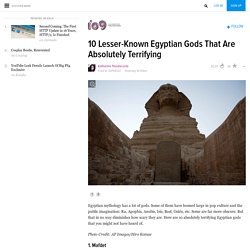
Here's another relief from inside the temple at Esna, showing Thoth and Horus anointing the king, along with a goddess I believe to be Menhit. The interior of the temple is quite well preserved as it was deliberately buried to protect it. Here you can see the temple is significantly lower than the contemporary city. From this angle you can see the relief of Menhit pictured in the article. There was also a statue of Menhit in the courtyard outside. Egypt is extremely quiet at the moment so I was able to freely explore all the temples I visited. Many of these sites are astonishingly well preserved considering their age, and there are some fascinating reliefs, some in obvious places, but others hidden away where you really have to look for them. Also, if you go to Luxor Temple it's good luck to rub the Pharaoh's member, and over countless centuries the hands of visitors have blackened the area.... Flagged. Archeologists discover Mythical Tomb of Osiris, God of the Dead, in Egypt.
A Spanish-Italian archaeological team, in cooperation with the Egyptian Ministry of Antiquities, has made an incredible discovery in the necropolis of Sheikh Abd el-Qurna, on the West Bank at Thebes, Egypt – an enormous ancient reproduction of the mythical Tomb of Osiris as described by Egyptian legend, complete with multiple shafts and chambers.
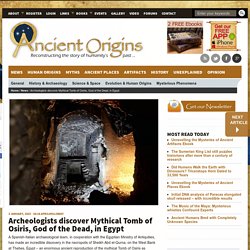
Inside the tomb complex, researchers found a carving of Osiris and a room with a wall relief depicting a demon holding knives. Ancient Egyptian Handbook of Spells Deciphered. Researchers have deciphered an ancient Egyptian handbook, revealing a series of invocations and spells.
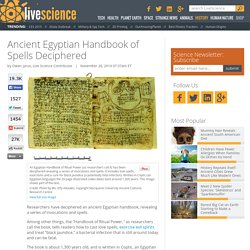
Among other things, the "Handbook of Ritual Power," as researchers call the book, tells readers how to cast love spells, exorcise evil spirits and treat "black jaundice," a bacterial infection that is still around today and can be fatal. The book is about 1,300 years old, and is written in Coptic, an Egyptian language. It is made of bound pages of parchment — a type of book that researchers call a codex. "It is a complete 20-page parchment codex, containing the handbook of a ritual practitioner," write Malcolm Choat and Iain Gardner, who are professors in Australia at Macquarie University and the University of Sydney, respectively, in their book, "A Coptic Handbook of Ritual Power" (Brepols, 2014).
The ancient book "starts with a lengthy series of invocations that culminate with drawings and words of power," they write. The Afterlife - Ancient Egypt for Kids. To the ancient Egyptians, the Land of Two Fields was a real place.
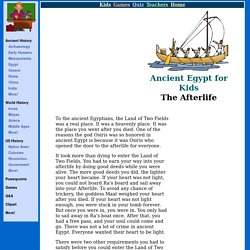
It was a heavenly place. It was the place you went after you died. One of the reasons the god Osiris was so honored in ancient Egypt is because it was Osiris who opened the door to the afterlife for everyone. It took more than dying to enter the Land of Two Fields. You had to earn your way into your afterlife by doing good deeds while you were alive. There were two other requirements you had to satisfy before you could enter the Land of Two Fields. If something happened to your preserved body, or if your name was not written down somewhere, the Ba and Ka would get lost on their way home. The Afterlife in Ancient Egypt. Share Posted 01.03.06 NOVA Unlike most scholars of the ancient world, Salima Ikram knows her subjects on an intimate, face-to-face basis.

In this interview, Ikram, an Egyptologist at the American University in Cairo, sheds light on why mummification was practiced in ancient Egypt, what the ancients thought the afterlife would be like, and why—of some 70 million mummies made—very few remain intact today. Like most ancient Egyptians, this wife of a pharaoh died young. But her body was prepared for a glorious afterlife. The allure of mummies NOVA: Why do you think people are so fascinated by mummies? The underworld and the afterlife in ancient Egypt. The Egyptian Afterlife and The Feather of Truth (Article) Is it possible to have a heart that is lighter than a feather?
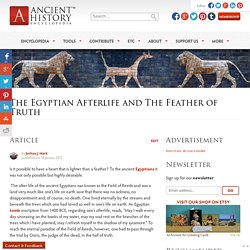
To the ancient Egyptians it was not only possible but highly desirable. Osireion. Duat. This article is about the Egyptian underworld.
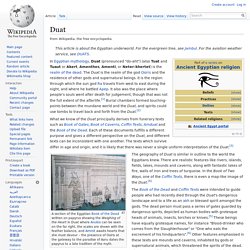
For the evergreen tree, see Jambul. For the aviation weather service, see DUATS. Ka. Amun. "Amen Ra" redirects here.
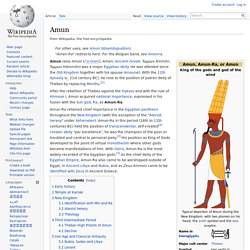
For the Belgian band, see Amenra. Amun (also Amon (/ˈɑːmən/), Amen; Ancient Greek: Ἄμμων Ámmōn, Ἅμμων Hámmōn) was a major Egyptian deity. He was attested since the Old Kingdom together with his spouse Amaunet. With the 11th dynasty (c. 21st century BC), he rose to the position of patron deity of Thebes by replacing Monthu.[1] Serapis. Serapis (Σέραπις, Attic/Ionian Greek) or Sarapis (Σάραπις, Doric Greek) is a Graeco-Egyptian god.

Cult of Serapis was introduced during the 3rd century BC on the orders of Ptolemy I of Egypt[1] as a means to unify the Greeks and Egyptians in his realm. The god was depicted as Greek in appearance, but with Egyptian trappings, and combined iconography from a great many cults, signifying both abundance and resurrection.